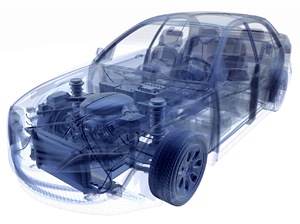A novel protocol for controlling electronic automotive systems operates ten times faster than conventional approaches
 c 2010 iStockphoto/weicheltfilm
c 2010 iStockphoto/weicheltfilmAlmost every element in a modern-day car is controlled or aided by a computer known as an electronic control unit (ECU). Ryo Kurachi and colleagues from Nagoya University, working in collaboration with AutoNetworks Technologies Ltd, have proposed1 a novel ECU connection architecture that allows units to communicate at unprecedented speeds of up to 10 megabits per second.
The latest cars can have in excess of 100 ECUs in charge of everything from managing the engine, braking and airbag systems to on-board entertainment and even seat heaters. These systems, or nodes, communicate through a device called a bus, which allows data to be transferred among the various units without the messages colliding with one another.
Systems called controller area networks (CANs) were developed in the 1980s to meet specific requirements of the automotive industry that were not met by traditional computer architectures. CANs incorporate a mechanism that decides which message has the highest priority, thereby reducing any delay in getting important data to its destination.
"The CAN protocol requires that a single bit of data must be available to all nodes simultaneously in order to enable arbitration and the acknowledgment sequence," explains Kurachi. "This means that the bit length must be greater than the longest communication distance between two nodes." This limitation imposes a maximum network speed of about one megabit per second. The technique is also limited in terms of the number of nodes that it can support.
The communication scheme developed by Kurachi and his co-workers--building on an event-triggered system in which messages are only sent when needed--minimizes the message propagation delay in a CAN by connecting all nodes to a central hub known as a multi-port gateway. They also improved the algorithm for determining when a message is sent and when a node should expect to receive data, and introduced a novel method for system recovery after a data collision.
The team then undertook a worst-case response analysis to assess how well a CAN would work in a real vehicle. These computer simulations proved that a 20-node system could successfully process a queue of 200 messages at a rate of ten megabits per second.
"The main advantage of our CAN over other proposals is that it can effectively and reliably attain a much higher bandwidth simply by replacing existing CAN hardware, with almost no need to change the software or drivers," says Kurachi.
Affiliated Researchers
The Nagoya University affiliated authors mentioned in this highlight are from the Center for Embedded Computing Systems
Reference
Kurachi, R., Takada, H., Teshima, S. & Miyashita, Y. Design and performance analysis of 10 Mbit/s CAN. SAE International Journal of Passenger Cars-Electronic and Electrical Systems 2, 18-26 (2009). | article